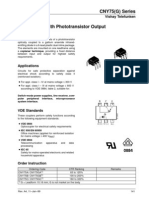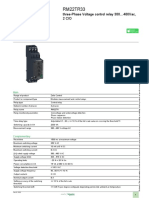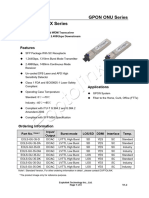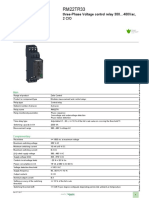Cosmo 1010 Optoacoplador
Cosmo 1010 Optoacoplador
Uploaded by
Pedro MorenoOriginal Description:
Copyright
Available Formats
Share this document
Did you find this document useful?
Is this content inappropriate?
Report this DocumentCopyright:
Available Formats
Cosmo 1010 Optoacoplador
Cosmo 1010 Optoacoplador
Uploaded by
Pedro MorenoCopyright:
Available Formats
TCET1100/ TCET1100G
Vishay Semiconductors
Optocoupler, Phototransistor Output, High Temperature
Features
• Extra low coupling capacity - typical 0.2 pF
• High Common Mode Rejection
• Low temperature coefficient of CTR C E
• CTR offered in 9 groups 4 3
• Reinforced Isolation provides circuit protection
against electrical shock (Safety Class II)
• Lead-free component
e3 Pb
1 2
• Component in accordance to RoHS 2002/95/EC V
D E
A C
and WEEE 2002/96/EC 17197_1
C Pb-free
Agency Approvals Pollution degree 2 (DIN/VDE 0110 / resp. IEC 60664)
• UL1577, File No. E76222 System Code U, Double Climatic classification 55/100/21 (IEC 60068 part 1)
Protection Rated impulse voltage (transient overvoltage)
• CSA 22.2 bulletin 5A, Double Protection VIOTM = 8 kV peak
• BSI: EN 60065:2002, EN 60950:2000 Isolation test voltage (partial discharge test voltage)
Certificate No. 7081 and 7402 Vpd = 1.6 kV
• DIN EN 60747-5-2 (VDE0884) Rated isolation voltage (RMS includes DC)
DIN EN 60747-5-5 pending VIOWM = 600 VRMS (848 V peak)
• FIMKO Rated recurring peak voltage (repetitive)
VIORM = 600 VRMS
Applications Thickness through insulation ≥ 0.75 mm
Switch-mode power supplies Internal creepage distance > 4 mm
Line receiver Creepage current resistance according to VDE 0303/
IEC 112 Comparative Tracking Index:
Computer peripheral interface
CTI ≥ 175
Microprocessor system interface
Circuits for safe protective separation against electri-
cal shock according to safety class II (reinforced iso- VDE Standards
lation): These couplers perform safety functions according to the following
• For appl. class I - IV at mains voltage ≤ 300 V equipment standards:
DIN EN 60747-5-2(VDE0884)/ DIN EN 60747-5-5
• For appl. class I - III at mains voltage ≤ 600 V accord-
pending
ing to DIN EN 60747-5-2(VDE0884)/ DIN EN 60747-
5-5 pending, table 2. Optocoupler for electrical safety requirements
IEC 60950/EN 60950
Description Office machines (applied for reinforced isolation for mains voltage
≤ 400 VRMS)
The TCET110. consists of a phototransistor optically
coupled to a gallium arsenide infrared-emitting diode VDE 0804
in a 4-lead plastic dual inline package. Telecommunication apparatus and data processing
The elements are mounted on one leadframe using a IEC 60065
coplanar technique, providing a fixed distance Safety for mains-operated electronic and related household appa-
between input and output for highest safety require- ratus
ments.
Isolation materials according to UL94-VO
Document Number 83503 www.vishay.com
Rev. 2.1, 26-Oct-04 1
TCET1100/ TCET1100G
Vishay Semiconductors
Order Information
Part Remarks
TCET1100 CTR 50 - 600 %, DIP-4
TCET1101 CTR 40 - 80 %, DIP-4
TCET1102 CTR 63 - 125 %, DIP-4
TCET1103 CTR 100 - 200 %, DIP-4
TCET1104 CTR 160 - 320 %, DIP-4
TCET1105 CTR 50 - 150 %, DIP-4
TCET1106 CTR 100 - 300 %, DIP-4
TCET1107 CTR 80 - 160 %, DIP-4
TCET1108 CTR 130 - 260 %, DIP-4
TCET1109 CTR 200 - 400 %, DIP-4
TCET1100G CTR 50 - 600 %, DIP-4
TCET1101G CTR 40 - 80 %, DIP-4
TCET1102G CTR 63 - 125 %, DIP-4
TCET1103G CTR 100 - 200 %, DIP-4
TCET1104G CTR 160 - 320 %, DIP-4
TCET1105G CTR 50 - 150 %, DIP-4
TCET1106G CTR 100 - 300 %, DIP-4
TCET1107G CTR 80 - 160 %, DIP-4
TCET1108G CTR 130 - 260 %, DIP-4
TCET1109G CTR 200 - 400 %, DIP-4
G = Leadform 10.16 mm; G is not marked on the body
Absolute Maximum Ratings
Tamb = 25 °C, unless otherwise specified
Stresses in excess of the absolute Maximum Ratings can cause permanent damage to the device. Functional operation of the device is
not implied at these or any other conditions in excess of those given in the operational sections of this document. Exposure to absolute
Maximum Rating for extended periods of the time can adversely affect reliability.
Input
Parameter Test condition Symbol Value Unit
Reverse voltage VR 6 V
Forward current IF 60 mA
Forward surge current tp ≤ 10 µs IFSM 1.5 A
Power dissipation Pdiss 100 mW
Junction temperature Tj 125 °C
Output
Parameter Test condition Symbol Value Unit
Collector emitter voltage VCEO 70 V
Emitter collector voltage VECO 7 V
Collector current IC 50 mA
Collector peak current tp/T = 0.5, tp ≤ 10 ms ICM 100 mA
Power dissipation Pdiss 150 mW
Junction temperature Tj 125 °C
www.vishay.com Document Number 83503
2 Rev. 2.1, 26-Oct-04
TCET1100/ TCET1100G
Vishay Semiconductors
Coupler
Parameter Test condition Symbol Value Unit
Isolation test voltage (RMS) t = 1 min VISO 5000 VRMS
Total power dissipation Ptot 250 mW
Operating ambient temperature Tamb - 40 to + 100 °C
range
Storage temperature range Tstg - 55 to + 125 °C
Soldering temperature 2 mm from case t ≤ 10 s Tsld 260 °C
Electrical Characteristics
Tamb = 25 °C, unless otherwise specified
Minimum and maximum values are testing requirements. Typical values are characteristics of the device and are the result of engineering
evaluation. Typical values are for information only and are not part of the testing requirements.
Input
Parameter Test condition Symbol Min Typ. Max Unit
Forward voltage IF = 50 mA VF 1.25 1.6 V
Junction capacitance VR = 0 V, f = 1 MHz Cj 50 pF
Output
Parameter Test condition Symbol Min Typ. Max Unit
Collector emitter voltage IC = 1 mA VCEO 70 V
Emitter collector voltage IE = 100 µA VECO 7 V
Collector-emitter cut-off current VCE = 20 V, If = 0, E = 0 ICEO 10 100 nA
Coupler
Parameter Test condition Symbol Min Typ. Max Unit
Collector emitter saturation IF = 10 mA, IC = 1 mA VCEsat 0.3 V
voltage
Cut-off frequency VCE = 5 V, IF = 10 mA, fc 110 kHz
RL = 100 Ω
Coupling capacitance f = 1 MHz Ck 0.3 pF
Document Number 83503 www.vishay.com
Rev. 2.1, 26-Oct-04 3
TCET1100/ TCET1100G
Vishay Semiconductors
Current Transfer Ratio
Parameter Test condition Part Symbol Min Typ. Max Unit
IC/IF VCE = 5 V, IF = 1 mA TCET1100 CTR 13 30 %
TCET1100G
TCET1102 CTR 22 45 %
TCET1102G
TCET1103 CTR 34 70 %
TCET1103G
TCET1104 CTR 56 90 %
TCET1104G
VCE = 5 V, IF = 5 mA TCET1100 CTR 50 600 %
TCET1100G
TCET1105 CTR 50 150 %
TCET1105G
TCET1106 CTR 100 300 %
TCET1106G
TCET1107 CTR 80 160 %
TCET1107G
TCET1108 CTR 130 260 %
TCET1108G
TCET1109 CTR 200 400 %
TCET1109G
VCE = 5 V, IF = 10 mA TCET1100 CTR 40 80 %
TCET1100G
TCET1102 CTR 63 125 %
TCET1102G
TCET1103 CTR 100 200 %
TCET1103G
TCET1104 CTR 160 320 %
TCET1104G
Maximum Safety Ratings
(according to DIN EN 60747-5-2(VDE0884)/ DIN EN 60747-5-5 pending) see figure 1
This optocoupler is suitable for safe electrical isolation only within the safety ratings.
Compliance with the safety ratings shall be ensured by means of suitable protective circuits.
Input
Parameter Test condition Symbol Min Typ. Max Unit
Forward current IF 130 mA
Output
Parameter Test condition Symbol Min Typ. Max Unit
Power dissipation Pdiss 265 mW
Coupler
Parameter Test condition Symbol Min Typ. Max Unit
Rated impulse voltage VIOTM 8 kV
Safety temperature Tsi 150 °C
www.vishay.com Document Number 83503
4 Rev. 2.1, 26-Oct-04
TCET1100/ TCET1100G
Vishay Semiconductors
Insulation Rated Parameters
Parameter Test condition Symbol Min Typ. Max Unit
Partial discharge test voltage - 100 %, ttest = 1 s Vpd 1.6 kV
Routine test
Partial discharge test voltage - tTr = 60 s, ttest = 10 s, VIOTM 8 kV
Lot test (sample test) (see figure 2)
Vpd 1.3 kV
Insulation resistance VIO = 500 V RIO 1012 Ω
VIO = 500 V, Tamb = 100 °C RIO 10 11 Ω
VIO = 500 V, Tamb = 150 °C RIO 109 Ω
(construction test only)
VIOTM
300 t1, t2 = 1 to 10 s
Ptot – Total Power Dissipation ( mW )
t3, t4 = 1 s
250 Phototransistor ttest = 10 s
Psi ( mW )
tstres = 12 s
200 VPd
150 VIOWM
VIORM
100
50 IR-Diode
Isi ( mA ) 0
t3 ttest t4
0 t1 tTr = 60 s t2 tstres
13930
0 25 50 75 100 125 150
t
94 9182 Tsi – Safety Temperature ( °C )
Figure 1. Derating diagram Figure 2. Test pulse diagram for sample test according to DIN EN
60747-5-2(VDE0884)/ DIN EN 60747-; IEC60747
Document Number 83503 www.vishay.com
Rev. 2.1, 26-Oct-04 5
TCET1100/ TCET1100G
Vishay Semiconductors
Switching Characteristics
Parameter Test condition Symbol Min Typ. Max Unit
Delay time VS = 5 V, IC = 2 mA, RL = 100 Ω td 3.0 µs
(see figure 3)
Rise time VS = 5 V, IC = 2 mA, RL = 100 Ω tr 3.0 µs
(see figure 3)
Turn-on time VS = 5 V, IC = 2 mA, RL = 100 Ω ton 6.0 µs
(see figure 3)
Storage time VS = 5 V, IC = 2 mA, RL = 100 Ω ts 0.3 µs
(see figure 3)
Fall time VS = 5 V, IC = 2 mA, RL = 100 Ω tf 4.7 µs
(see figure 3)
Turn-off time VS = 5 V, IC = 2 mA, RL = 100 Ω toff 5.0 µs
(see figure 3)
Turn-on time VS = 5 V, IF = 10 mA, RL = 1 kΩ ton 9.0 µs
(see figure 4)
Turn-off time VS = 5 V, IF = 10 mA, RL = 1 kΩ toff 10.0 µs
(see figure 4)
IF 96 11698
IF IF +5V 0
0 tp t
IC = 2 mA; adjusted through IC
input amplitude 100%
90%
RG = 50 W
tp
= 0.01
T
tp = 50 Ps
Channel I 10%
Oscilloscope 0
RL = 1 MW tr
Channel II td t
CL = 20 pF ts tf
50 W 100 W ton toff
tp pulse duration ts storage time
td delay time tf fall time
95 10804 tr rise time toff (= ts + tf) turn-off time
ton (= td + tr) turn-on time
Figure 3. Test circuit, non-saturated operation Figure 5. Switching Times
IF IF = 10 mA +5V
0
IC
RG = 50 Ω
tp
= 0.01
T
tp = 50 µs
Channel I
Oscilloscope
Channel II RL≥ 1M Ω
CL ≤ 20 pF
50 Ω 1 kΩ
95 10843
Figure 4. Test circuit, saturated operation
www.vishay.com Document Number 83503
6 Rev. 2.1, 26-Oct-04
TCET1100/ TCET1100G
Vishay Semiconductors
Typical Characteristics (Tamb = 25 °C unless otherwise specified)
10000
300
I CEO - Collector Dark Current,
V CE = 20 V
P tot –Total Power Dissipation ( mW)
Coupled device IF = 0
with open Base ( nA )
250 1000
200
Phototransistor
100
150
IR-diode
100
10
50
0 1
0 40 80 120 0 25 50 75 100
96 11700 Tamb – Ambient Temperature( °C ) 95 11026 Tamb - Ambient Temperature ( ° C )
Figure 6. Total Power Dissipation vs. Ambient Temperature Figure 9. Collector Dark Current vs. Ambient Temperature
100
1000 IC – Collector Current ( mA ) V CE=5V
10
I F - Forward Current ( mA )
100
1
10
1 0.1
0.1 0.01
0 0.2 0.4 0.6 0.8 1.0 1.2 1.4 1.6 1.8 2.0 0.1 1 10 100
96 11862 V F - Forward Voltage ( V ) 95 11027 I F – Forward Current ( mA )
Figure 7. Forward Current vs. Forward Voltage Figure 10. Collector Current vs. Forward Current
2.0 100
CTRrel – Relative Current Transfer Ratio
V CE=5V 20mA
IC – Collector Current ( mA)
I F=5mA I F=50mA
1.5
10mA
10
5mA
1.0
1 2mA
0.5
1mA
0 0.1
–25 0 25 50 75 0.1 1 10 100
95 11025 Tamb – Ambient Temperature ( °C ) 95 10985 V CE – Collector Emitter Voltage ( V )
Figure 8. Relative Current Transfer Ratio vs. Ambient Figure 11. Collector Current vs. Collector Emitter Voltage
Temperature
Document Number 83503 www.vishay.com
Rev. 2.1, 26-Oct-04 7
TCET1100/ TCET1100G
Vishay Semiconductors
VCEsat– Collector Emitter Saturation Voltage (V)
1.0 50
ton / toff –Turn on / Turn off Time ( µ s )
20% Saturated Operation
0.8 40 V S=5V
RL=1k Ω
CTR=50%
0.6 30
toff
0.4 20
0.2 10
10%
ton
0 0
1 10 100 0 5 10 15 20
95 11028 I C – Collector Current ( mA ) 95 11031 I F – Forward Current ( mA )
Figure 12. Collector Emitter Saturation Voltage vs. Collector Figure 15. Turn on / off Time vs. Forward Current
Current
1000
CTR – Current Transfer Ratio ( % )
V CE=5V
100
10
1
0.1 1 10 100
95 11029 I F – Forward Current ( mA )
Figure 13. Current Transfer Ratio vs. Forward Current
10
ton / toff –Turn on / Turn off Time ( µ s )
Non Saturated
Operation
8 V S=5V
ton RL=100 Ω
6
toff
4
0
0 2 4 6 10
95 11030 I C – Collector Current ( mA )
Figure 14. Turn on / off Time vs. Collector Current
www.vishay.com Document Number 83503
8 Rev. 2.1, 26-Oct-04
TCET1100/ TCET1100G
Vishay Semiconductors
Package Dimensions in mm
14789
Package Dimensions in mm
14792
Document Number 83503 www.vishay.com
Rev. 2.1, 26-Oct-04 9
TCET1100/ TCET1100G
Vishay Semiconductors
Ozone Depleting Substances Policy Statement
It is the policy of Vishay Semiconductor GmbH to
1. Meet all present and future national and international statutory requirements.
2. Regularly and continuously improve the performance of our products, processes, distribution and
operatingsystems with respect to their impact on the health and safety of our employees and the public, as
well as their impact on the environment.
It is particular concern to control or eliminate releases of those substances into the atmosphere which are
known as ozone depleting substances (ODSs).
The Montreal Protocol (1987) and its London Amendments (1990) intend to severely restrict the use of ODSs
and forbid their use within the next ten years. Various national and international initiatives are pressing for an
earlier ban on these substances.
Vishay Semiconductor GmbH has been able to use its policy of continuous improvements to eliminate the use
of ODSs listed in the following documents.
1. Annex A, B and list of transitional substances of the Montreal Protocol and the London Amendments
respectively
2. Class I and II ozone depleting substances in the Clean Air Act Amendments of 1990 by the Environmental
Protection Agency (EPA) in the USA
3. Council Decision 88/540/EEC and 91/690/EEC Annex A, B and C (transitional substances) respectively.
Vishay Semiconductor GmbH can certify that our semiconductors are not manufactured with ozone depleting
substances and do not contain such substances.
We reserve the right to make changes to improve technical design
and may do so without further notice.
Parameters can vary in different applications. All operating parameters must be validated for each
customer application by the customer. Should the buyer use Vishay Semiconductors products for any
unintended or unauthorized application, the buyer shall indemnify Vishay Semiconductors against all
claims, costs, damages, and expenses, arising out of, directly or indirectly, any claim of personal
damage, injury or death associated with such unintended or unauthorized use.
Vishay Semiconductor GmbH, P.O.B. 3535, D-74025 Heilbronn, Germany
Telephone: 49 (0)7131 67 2831, Fax number: 49 (0)7131 67 2423
www.vishay.com Document Number 83503
10 Rev. 2.1, 26-Oct-04
This datasheet has been download from:
www.datasheetcatalog.com
Datasheets for electronics components.
You might also like
- Tcet1100 TDK FerriteDocument9 pagesTcet1100 TDK FerriteRyn YahuFNo ratings yet
- CQY80N/ CQY80NG: Optocoupler, Phototransistor Output, With Base ConnectionDocument11 pagesCQY80N/ CQY80NG: Optocoupler, Phototransistor Output, With Base ConnectionAbdelwhab ElsaftyNo ratings yet
- This Datasheet Is Presented by The Manufacturer Dieses Datenblatt Wird Vom Hersteller Bereitgestellt Cette Fiche Technique Est Présentée Par Le FabricantDocument12 pagesThis Datasheet Is Presented by The Manufacturer Dieses Datenblatt Wird Vom Hersteller Bereitgestellt Cette Fiche Technique Est Présentée Par Le FabricantMohamed Choukri AzzoulaNo ratings yet
- Tcet110 - Tcet2100 Tcet4100 PDFDocument11 pagesTcet110 - Tcet2100 Tcet4100 PDFMarcio ShiinoNo ratings yet
- Datasheet ET1100Document10 pagesDatasheet ET1100Manal FeghaliNo ratings yet
- TCLT10.. Series: Vishay TelefunkenDocument12 pagesTCLT10.. Series: Vishay TelefunkenRaul CondorNo ratings yet
- ACPL C87B ACPL C87A ACPL C870 Precision Optically Isolated Voltage SensorDocument14 pagesACPL C87B ACPL C87A ACPL C870 Precision Optically Isolated Voltage SensorlavaNo ratings yet
- ETD-SL-2T-I: Timer Relay With Adjustable Pulse and Pause TimesDocument6 pagesETD-SL-2T-I: Timer Relay With Adjustable Pulse and Pause TimesviolorenoNo ratings yet
- DO880Document4 pagesDO880sitaNo ratings yet
- Zelio Control Relays - RM4UB35Document8 pagesZelio Control Relays - RM4UB35Variya DharmeshNo ratings yet
- Tiron - Stopping Machines - XY2CE2A270Document4 pagesTiron - Stopping Machines - XY2CE2A270VIJAVARHOTMAILCOMNo ratings yet
- Schneider Electric Zelio-Control-Relays RM4UB35Document9 pagesSchneider Electric Zelio-Control-Relays RM4UB35ahmed.farrag.hassan92No ratings yet
- Phase Filler RM17TE00 - DATASHEET - US - en-USDocument6 pagesPhase Filler RM17TE00 - DATASHEET - US - en-USANo ratings yet
- Cny75Document11 pagesCny75jhanusNo ratings yet
- Phoenix Contact PDFDocument9 pagesPhoenix Contact PDFAdarsh BhandariNo ratings yet
- ATS22D88S6U: Product Data SheetDocument12 pagesATS22D88S6U: Product Data SheetRene AlfaroNo ratings yet
- Fully-Differential Isolation Amplifier: Features DescriptionDocument23 pagesFully-Differential Isolation Amplifier: Features DescriptionbakozoltanNo ratings yet
- Relay de Phase Schneider RM22TG20Document7 pagesRelay de Phase Schneider RM22TG20ticojfsNo ratings yet
- Zelio Control Relays - RM22TR33Document7 pagesZelio Control Relays - RM22TR33aditya agasiNo ratings yet
- Val-Ms 60 ST: Order No.: 2807573Document7 pagesVal-Ms 60 ST: Order No.: 2807573MeleNo ratings yet
- IL55B/ 56B/ MOC8021: Optocoupler, Photodarlington Output, High GainDocument6 pagesIL55B/ 56B/ MOC8021: Optocoupler, Photodarlington Output, High GainCarlos Arias LuyandoNo ratings yet
- Zelio Control - RM22TR33Document7 pagesZelio Control - RM22TR33Mohamed ElBadryNo ratings yet
- Product SD832Document3 pagesProduct SD832Hernan Humberto Castañeda MendozaNo ratings yet
- Preventa XY2C - XY2CE1A250Document4 pagesPreventa XY2C - XY2CE1A250Anonymous DefbSuwiNo ratings yet
- Datasheet - SRB-E-212ST: Ordering DetailsDocument6 pagesDatasheet - SRB-E-212ST: Ordering DetailsIehab MereenNo ratings yet
- Stopping Machines - XY2CE1A270Document4 pagesStopping Machines - XY2CE1A270VIJAVARHOTMAILCOMNo ratings yet
- Quint DC Ups 24dc 20Document9 pagesQuint DC Ups 24dc 20danielliram993No ratings yet
- 700W1000W User Manual PDFDocument19 pages700W1000W User Manual PDFvanhuong87No ratings yet
- CROUZETDocument4 pagesCROUZETmongersonNo ratings yet
- QUINT-PS24DC48DC5 DC To DC ConverterDocument9 pagesQUINT-PS24DC48DC5 DC To DC ConverterMoutaz KhaterNo ratings yet
- Zelio Control Relays - RM22TU23Document7 pagesZelio Control Relays - RM22TU23abdul haseebNo ratings yet
- PFF RM4TG20Document7 pagesPFF RM4TG20Dario CuscuetaNo ratings yet
- Llaves Termicas S200 80 A y 100 ADocument8 pagesLlaves Termicas S200 80 A y 100 AabrahambarcazaNo ratings yet
- Zelio Control Relays - RM4TG20Document8 pagesZelio Control Relays - RM4TG20Rhyan EdwinNo ratings yet
- 09 FCS084 A09 1 PDFDocument2 pages09 FCS084 A09 1 PDFsaurabh kumarNo ratings yet
- Harmony Control Relays - RM22TG20Document7 pagesHarmony Control Relays - RM22TG20Hr100% (1)
- Zelio Control Relays - RM22TR33Document7 pagesZelio Control Relays - RM22TR33Cesar MachadoNo ratings yet
- Zelio Control Relays - RM22TR33Document7 pagesZelio Control Relays - RM22TR33SIVARAMANJAGANATHANNo ratings yet
- CQY80N, CQY80NG: Vishay SemiconductorsDocument8 pagesCQY80N, CQY80NG: Vishay SemiconductorsHELLOGREGNo ratings yet
- Zelio Control Relays - RM22TG20 DatasheetDocument7 pagesZelio Control Relays - RM22TG20 DatasheetMinh NhậtNo ratings yet
- Tdf10 NewDocument2 pagesTdf10 NewSơn Lê CaoNo ratings yet
- Zelio Control Relays - RM22TR33Document7 pagesZelio Control Relays - RM22TR33Dominic DomNo ratings yet
- General InformationDocument3 pagesGeneral InformationsrobayocNo ratings yet
- Datasheet 709627 Solid State Relay Module Emg 12 Ov 24dc 60dc1 2948746 Phoenix ContactDocument5 pagesDatasheet 709627 Solid State Relay Module Emg 12 Ov 24dc 60dc1 2948746 Phoenix Contactkentron75No ratings yet
- Schneider Electric - Harmony-Control-Relays - RM22TR33Document9 pagesSchneider Electric - Harmony-Control-Relays - RM22TR33mahmoudebrahim96745No ratings yet
- Eols Gu 35XXDocument8 pagesEols Gu 35XXTestgame GameonlyNo ratings yet
- Power Supply Pro Eco 120W 24V 5a PDFDocument5 pagesPower Supply Pro Eco 120W 24V 5a PDFEdgar Castillo MartínezNo ratings yet
- IDNFCDALI75WDocument4 pagesIDNFCDALI75WdarshNo ratings yet
- PON Series EOLS-GT-25 Series: FeaturesDocument10 pagesPON Series EOLS-GT-25 Series: FeatureselgaisyNo ratings yet
- Harmony Control Relays - RM22TR33Document8 pagesHarmony Control Relays - RM22TR33syed ajmalNo ratings yet
- CNY75 OptocouplerDocument14 pagesCNY75 OptocouplerJanus VananusNo ratings yet
- Zelio Control Relays - RM22TR31-1Document3 pagesZelio Control Relays - RM22TR31-1GCN.MauricioNo ratings yet
- Schneider 3P Control Relay RM22TR33Document7 pagesSchneider 3P Control Relay RM22TR33Manuel RejanoNo ratings yet
- Eols GT 35Document9 pagesEols GT 35Testgame GameonlyNo ratings yet
- Zelio Control Relay RM4TR35Document7 pagesZelio Control Relay RM4TR35Abdul Majeed SurmawalaNo ratings yet
- RM4TR32 DatasheetDocument9 pagesRM4TR32 DatasheetMinh HùngNo ratings yet
- Protect Ie 11 2024 07 01 14 47Document7 pagesProtect Ie 11 2024 07 01 14 47vramosNo ratings yet
- Zelio Control Relays - RM22TG20Document7 pagesZelio Control Relays - RM22TG20lorentz franklinNo ratings yet
- Schrack Relay Package PT: General Purpose Relays Product SetsDocument3 pagesSchrack Relay Package PT: General Purpose Relays Product SetsMaduroNo ratings yet
- Analog Dialogue Volume 46, Number 1: Analog Dialogue, #5From EverandAnalog Dialogue Volume 46, Number 1: Analog Dialogue, #5Rating: 5 out of 5 stars5/5 (1)
- Kenwood A-H5 PDFDocument13 pagesKenwood A-H5 PDFPedro MorenoNo ratings yet
- AV555 323742 English Specific PDFDocument40 pagesAV555 323742 English Specific PDFPedro MorenoNo ratings yet
- Vertical Deflection Booster: DescriptionDocument6 pagesVertical Deflection Booster: DescriptionPedro MorenoNo ratings yet
- PLCC Sockets: Plastic Leaded Chip Carrier Socket Surface MountDocument5 pagesPLCC Sockets: Plastic Leaded Chip Carrier Socket Surface MountPedro MorenoNo ratings yet
- KC503 DatasheetDocument104 pagesKC503 DatasheetPedro MorenoNo ratings yet
- Visual Basic Programming For Beginners - A Complete Beginners Guide To Learn The Fundamentals of Visual BasicDocument187 pagesVisual Basic Programming For Beginners - A Complete Beginners Guide To Learn The Fundamentals of Visual BasicPedro Moreno67% (3)
- Effects of Residual Elements On The Corrosion Resistance of Steels in HF (51300-97513-SG)Document12 pagesEffects of Residual Elements On The Corrosion Resistance of Steels in HF (51300-97513-SG)arnoldbatista55No ratings yet
- 12V 7ah (20hr) : Battery ConstructionDocument2 pages12V 7ah (20hr) : Battery ConstructionCao Chi KienNo ratings yet
- Hz9n50en - En647 Univer Digital Pressure SwitchDocument2 pagesHz9n50en - En647 Univer Digital Pressure SwitchMohammad Adeel KhanNo ratings yet
- Report On Transformer Audit: Presented By: JAYARAJAN C NDocument13 pagesReport On Transformer Audit: Presented By: JAYARAJAN C NMidhun VargheseNo ratings yet
- 2D4GHz VCO Process Vehicle Design Report 2007Document29 pages2D4GHz VCO Process Vehicle Design Report 2007Tiến Trần TrọngNo ratings yet
- Amrut Solar Water Pumping SystemDocument10 pagesAmrut Solar Water Pumping SystemraushanphulwariNo ratings yet
- Practical Work 6Document11 pagesPractical Work 6Kalai ShanNo ratings yet
- Datasheet RadiusexbatteryDocument1 pageDatasheet RadiusexbatteryAzmi MahamadNo ratings yet
- ELS 2202 Week 2 (1) .PPT - PpsDocument61 pagesELS 2202 Week 2 (1) .PPT - PpsYohana Crisma LimbongNo ratings yet
- ST202EB - ST202EC ST232EB - ST232EC: 15 KV ESD Protected 5 V RS-232 TransceiverDocument18 pagesST202EB - ST202EC ST232EB - ST232EC: 15 KV ESD Protected 5 V RS-232 Transceiverronald david guerra alvarezNo ratings yet
- 567alcohol Detection Using Smart Helmet System PDFDocument6 pages567alcohol Detection Using Smart Helmet System PDFRahulNo ratings yet
- Ametek Series 90B AnnunciatorDocument2 pagesAmetek Series 90B AnnunciatorWaleed MareeNo ratings yet
- Chapter 03.00E Physical Problem For Nonlinear Equations Electrical EngineeringDocument3 pagesChapter 03.00E Physical Problem For Nonlinear Equations Electrical EngineeringAnonymous B1gdy1j5No ratings yet
- Smart Meters Demand Side Response Leaflet - DR - FINALDocument8 pagesSmart Meters Demand Side Response Leaflet - DR - FINALvictelecNo ratings yet
- Physics Project: Reliance Foundation SchoolDocument14 pagesPhysics Project: Reliance Foundation SchoolShahrukh MominNo ratings yet
- Fast Distributed Reactive Power Control For Voltage Regulation in Distribution NetworksDocument4 pagesFast Distributed Reactive Power Control For Voltage Regulation in Distribution NetworksRianti TampubolonNo ratings yet
- Rotor NL - 5RN - 100 - 160Document4 pagesRotor NL - 5RN - 100 - 160saranNo ratings yet
- 10 17694-Bajece 1096188-2343685Document6 pages10 17694-Bajece 1096188-2343685Meral MeralNo ratings yet
- Diode - Definition, VI Characteristics, and Breakdown in Zener Diode - DiodeDocument8 pagesDiode - Definition, VI Characteristics, and Breakdown in Zener Diode - DiodehavejsnjNo ratings yet
- DC-DC Total Flyfarwd - Unit1&2.7&8Document41 pagesDC-DC Total Flyfarwd - Unit1&2.7&8Abhishek PatelNo ratings yet
- Tda 1548Document20 pagesTda 1548Jennifer NealNo ratings yet
- Seminar Ieee Format 2Document4 pagesSeminar Ieee Format 2Aswithareddy AswithareddyNo ratings yet
- Quick Charge Device ListDocument20 pagesQuick Charge Device ListDivyanshu BhushanNo ratings yet
- Inline Terminal - IB IL AO 4/I/4-20-ECO - 2702497: Product DescriptionDocument10 pagesInline Terminal - IB IL AO 4/I/4-20-ECO - 2702497: Product DescriptionGustavo CochachínNo ratings yet
- 2 NetworkDocument16 pages2 NetworkSukhee ByambaaNo ratings yet
- FGG.00.304.CLAD35: # WiresDocument3 pagesFGG.00.304.CLAD35: # WiresJoséNo ratings yet
- Generator Sizing For A Motor Load - Electric Motors, Generators & Controls Engineering FAQ - Eng-TipsDocument1 pageGenerator Sizing For A Motor Load - Electric Motors, Generators & Controls Engineering FAQ - Eng-TipsamrezzatNo ratings yet
- Start PMSMDocument4 pagesStart PMSMmohamed omarNo ratings yet
- Tutorial On Computer-Aided Analysis Switched-Capacitor CircuitsDocument19 pagesTutorial On Computer-Aided Analysis Switched-Capacitor CircuitsnidhalNo ratings yet
- Datasheet - Alcaldía Bogotá - Imprenta Distrital - 0513-2020 - Bogotá D.C. - On PDFDocument5 pagesDatasheet - Alcaldía Bogotá - Imprenta Distrital - 0513-2020 - Bogotá D.C. - On PDFAbelino Vargas TenjoNo ratings yet































































































